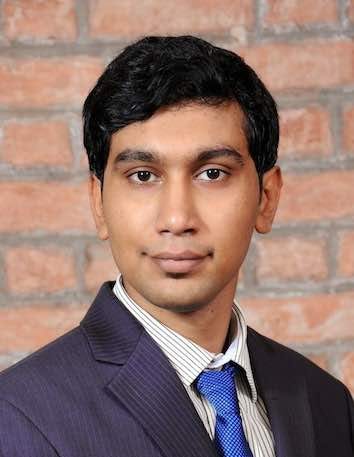Gyan with Technology at ‘Gyan Saarthi’

Progress hasn’t conformed just to the switch from chalk to marker, but the Indian Education system has transgressed in its nuances. Hefty lesson guides have been replaced by online portals that educate while they entertain. Lessons aren’t just about lectures but rather an assortment of digital aids and exercises. Gyan Saarthi, like the other standouts, represents this change in the teaching world. Conceived over conversation, “Gyan Saarthi” is the brainchild of Rahil Sheikh and Tirth Raj Bhutoria.
Rahil Sheikh, an IIM Ahmedabad and IIT Kanpur alum was dining with his professor, an Ex-Director of IIM-B, when their conversation drifted towards the Indian Education system and its problems. His professor’s words still resonate in his mind, he recalls him telling — “that success in future can be determined by the education received at the institute level. A great institute is not the one with big walls but with the morals that holds the bricks. Freedom, structure and pedagogy are key factors determining the success of a student.” This conversation struck a chord in him, and his deep-felt desire to be an entrepreneur had finally found a direction with an issue that was close to his heart!

Born in a small town, Chhitorgarh, Rahil had encountered disparities among his colleagues at office who came from big private schools. Having experienced it first-hand, he could understand the difference a good schooling could create. With better communication skills and greater confidence, the students from such schools easily succeeded in comparison to others who had to spend extra time.
It is alarming to note that a greater percentage of students in the country do face this issue, as per the ASER report 2017, about 25% of children between the age group of 14–18 cannot read basic text fluently in their own language. 53% of all 14 year olds in the sample of 28,323 youth can read english sentences, for 18 year olds the figure is closer to 60%. Of those who can read english sentences, only 79% can tell the meaning of those sentences.
Rahil started figuring out the exact issues in the system during his second year at IIM. He went on to teach at local schools to know where the pain points lie. He found that rote learning was a major issue. Children were dictated answers and asked to note them down thus involving no strong brain activity. Students were complimented for good writing which meant ‘good handwriting’ and not ‘creative writing’. Teachers were neither empowered nor encouraged to bring creativity into the classroom.
His will got deeper when he visited his town during vacations, only to find his peers unemployed or still struggling to figure their lives out. The reason for ‘unemployability’ and not ‘unemployment’, is the learning crisis in India; children are enrolled in schools but fail to learn even the basics! It’s estimated that the crisis may begin long before children even enter grade 1. As per the IECEI Study seven out of ten sampled 4-year olds already attend a school programme. With access being no longer the issue, children still lack quality education.
Encouraged by such experiences, Rahil Sheikh and his friend, Tirth Raj Bhutoria, a Teach For India Fellow, together founded ‘Gyan Saarthi’, with a vision to provide access to affordable and excellent education across India.
According to a report by McKinsey, estimates are that less than 5% of all occupations can be automated entirely using demonstrated technologies, about 60% of all occupations have atleast 30% of constituent activities. So, it becomes imperative to educate the young India, who would join the workforce in the next 10–15 years with the skills required for coming age with the transition of the workforce structure.
So how is ‘Gyan Saarthi’ solving the problem of ‘unemployability’?
Choosing to be different, the founders after deep research decided to pay a lot of emphasis on reading fluency. Another focus area for their schools is Comprehension. Contrary to other schools where answers are dictated and children are asked to copy them twice, once in class and then again as homework, Gyan Saarthi follows a different pedagogy. Children read one story a day viz a viz 15 over a year in a textbook, which is substantially a bigger number when compared!
Another way they instil creativity is by following a 5 step process. They ask the children to draw on Monday, followed by a story writing session on the same picture on Tuesday, classes on Wednesday begin with describing characteristics of the drawing, with validation by the teacher on Thursday and classroom presentations on Friday. This entire process covers a week thus infusing creativity, articulation, better communication skills, and self confidence. Gyan Saarthi understands teachers as primary change makers in small towns, thus has designed programs to train teachers to follow a particular pedagogy. They also focus on spreading awareness in the towns by organising workshops for parents once a month compared to a semi-annual one in other schools. These meetings track the progress of their children and also helps the parents in imbibing a learning culture of at home.

Currently with an impact on 250 children, with their holistic approach in the town schools of Gangapur City, from primary to 4th class, Gyan Saarthi is here to stay. They plan on expanding geographically and vertically. They believe in the driving skills of future, the 3 C’s — Collaboration, Creativity, and Communication. They dream of future bereft of unemployability! They believe in schools like theirs to achieve this dream!
Gyan Saarthi is supported by CIIE under the IIMAvericks Program. The IIMAvericks program provides mentoring and financial support to graduating students of IIMA to take the road less travelled and start-up.
To know more log on to : www.gyansaarthi.in
